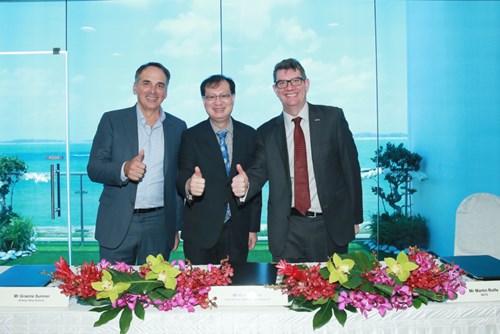Global Air Navigation Service Providers to Collaborate on Cutting Long Haul Flight Delays

Gathered at the Singapore Airshow 2018 today, the Chief Executives of three of the world’s leading air navigation service providers (ANSPs) signed a tripartite collaboration agreement to improve the on-time performance of long haul air traffic.
In this tripartite collaboration, Airways New Zealand (Airways NZ), the Civil Aviation Authority of Singapore (CAAS) and the UK NATS will work together to manage the time some selected flights spend in the cruise phase in order to minimise time spent in airborne holding upon arrival. Traditionally, ANSPs have had limited influence on an aircraft’s speed and movement outside the airspace they manage. Hence, this project aims to allow the management of arrivals over a substantially greater horizon, with no limit on the operational range, potentially providing a truly global solution to the pressing challenge of arrival delays.
This collaboration will explore an ATM technique known as Long Range Air Traffic Flow Management. Air traffic controllers will work with airlines to make marginal speed adjustments to flights during their en-route phase to better manage arrival times. As part of the initial stages of the collaboration, the three partners conducted trials involving 53 flights arriving into Changi from Auckland, Christchurch and London Heathrow, from 21 December 2017 to 5 January 2018. Through the application of the Long Range Air Traffic Flow Management concept, the trials proved successful, and demonstrated potential to redistribute airborne delays to the more fuel efficient cruising phase.
For seasoned travellers, airborne holding is a regular part of the experience when arriving at Heathrow Airport, with each aircraft spending an average time of six minutes circling in one of four holding stacks. Burgeoning air traffic growth in the Asia Pacific has presented new but similar challenges in this region. IATA has estimated in 2016 that airborne holding costs the region’s airports and airlines almost US$300 million every year in delays and unnecessary fuel burn.
Improved management of long haul arrivals will help to reduce airspace congestion and delay, enable greater predictability in operations for both the airlines and airports, while also help to reduce operational complexity for air traffic controllers.
Martin Rolfe, NATS Chief Executive Officer, said, “This is a hugely ambitious project, bringing together three of the world’s most progressive ANSPs to help make a meaningful difference to our airline and airport customers. NATS has already had success with arrivals management at Heathrow, but it is exciting to think of what we can now achieve working together on a global scale.”
Kevin Shum, Director-General of CAAS, said, “We are pleased to embark on this project with Airways NZ and NATS. We believe the collaboration will deliver increased operational efficiency and optimised usage of resources, which is especially crucial in managing the Asia Pacific’s ever-increasing air traffic volumes.”
Graeme Sumner, Airways New Zealand Chief Executive Officer, said, “Our initial trials indicate that this technique is good news for travellers, airlines and airports. By actively managing aircraft speeds much earlier in the flight, we estimate we could save an airline US$3.7 million a year in fuel costs and around four minutes of flying time per flight, all while achieving greater predictability of the arrival flows to airports.”


.jpg)


.png)



Comments
There are no comments yet for this item
Join the discussion